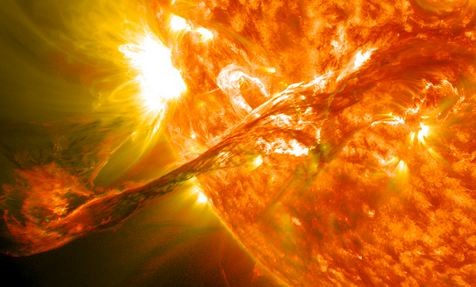Massive Sunspots Shooting X-Class Solar Flares Toward Earth Could Disrupt Technology
| Dino Lirios | | Oct 24, 2014 10:29 PM EDT |
A huge sunspot launching solar flares is currently directed and heading to Earth, with the potential to disrupt technology at any moment.
The sunspot is the largest that has been shot toward the Earth in the last 24 years. Judging by its size, it has the potential to shoot aurora-generating solar flares that can disrupt devices that we are using.
Like Us on Facebook
Labeled as AR 12192, the sunspot is actually a cooler area of the sun that has the potential to be a source for flares and coronal mass ejections.
The coronal mass injections are massive bursts of solar winds and magnetic fields that rise above the solar corona and are then released onto space. Alone it isn't much of a threat, but combine that with the flares and you get something dangerous to people.
In the previous five days, AR 12192 has produced two X-class flares, the most extreme category of flares.
The current solar cycle usually has sunspot region like these as its activity is at its peak.
The partial solar eclipse this past week gave sun observers the opportunity to see the massive sunspot. With the right protection, people could have seen that the area measured 80,000 miles across, wide enough for 10 Earths to be laid across its diameter.
The flares have already created some interesting auroras, which could lead to some radio blackouts.
However, it is the large coronal mass ejections that, when it reaches Earth, could disrupt radio and satellite communications, and even electricity generation at its severest.
Fortunately, the coronal mass ejections are traveling much slower than the flares. If a large ejection was headed toward the Earth, scientists would be able to pick up on it and give us a few days warning.
Several radio signals have already been affected by the flares.
Spaceweather.com warns people that the effects on Earth could increase in the following days as the active region causing powerful explosions is pointing toward Earth.
The National Oceanic and Atmospheric Administration (NOAA) estimates a 85% chance of an M-class flare and a 45% chance of an X-class flare in the next 24 hours.
Tagssolar flares, Earth, Sunspot, AR 12192, X Class
©2015 Chinatopix All rights reserved. Do not reproduce without permission
EDITOR'S PICKS
-

Did the Trump administration just announce plans for a trade war with ‘hostile’ China and Russia?
-

US Senate passes Taiwan travel bill slammed by China
-

As Yan Sihong’s family grieves, here are other Chinese students who went missing abroad. Some have never been found
-

Beijing blasts Western critics who ‘smear China’ with the term sharp power
-

China Envoy Seeks to Defuse Tensions With U.S. as a Trade War Brews
-

Singapore's Deputy PM Provides Bitcoin Vote of Confidence Amid China's Blanket Bans
-

China warns investors over risks in overseas virtual currency trading
-

Chinese government most trustworthy: survey
-

Kashima Antlers On Course For Back-To-Back Titles
MOST POPULAR
LATEST NEWS
Zhou Yongkang: China's Former Security Chief Sentenced to Life in Prison

China's former Chief of the Ministry of Public Security, Zhou Yongkang, has been given a life sentence after he was found guilty of abusing his office, bribery and deliberately ... Full Article
TRENDING STORY

China Pork Prices Expected to Stabilize As The Supplies Recover

Elephone P9000 Smartphone is now on Sale on Amazon India

There's a Big Chance Cliffhangers Won't Still Be Resolved When Grey's Anatomy Season 13 Returns

Supreme Court Ruled on Samsung vs Apple Dispute for Patent Infringement

Microsoft Surface Pro 5 Rumors and Release Date: What is the Latest?










